Velvet is a dense, durable fabric with longitudinal ribs on the front side. This material is ideal for sewing stylish, durable skirts of different styles, which can be worn by women of any age.
Sewing from such fabric is a little more difficult than from smooth materials that do not have a textured surface. But with the right pattern and the necessary materials, any woman can sew an original skirt on her own.
Skirt with elastic band
A velveteen skirt (stylists recommend choosing styles for women according to body type) is an essential element of the wardrobe of many fashionistas who value practicality, comfort and versatility.
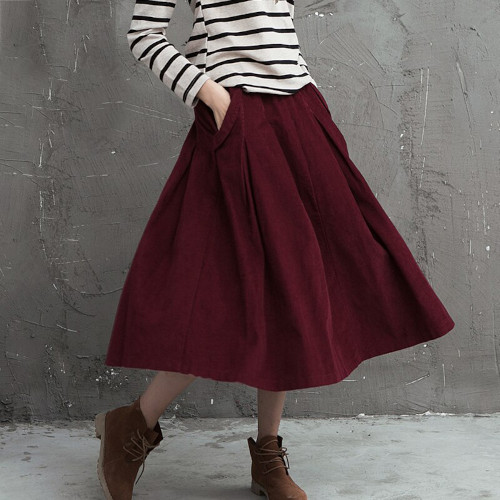
You can sew a skirt yourself if you buy the fabric you like in advance, prepare the necessary materials and tools. There is no need to waste time on creating a pattern, since this model of skirt is classic and one of the easiest to sew.
Before you start working, you need to write down the circumference of your hips, waist and the desired length of the product.
A practical and stylish elasticated skirt is a classic in the fashion world, and even a woman who does not have the necessary skills in working with patterns can make such a thing on her own. For work, you will need high-quality fabric so that the product does not lose its shape after the first wash.
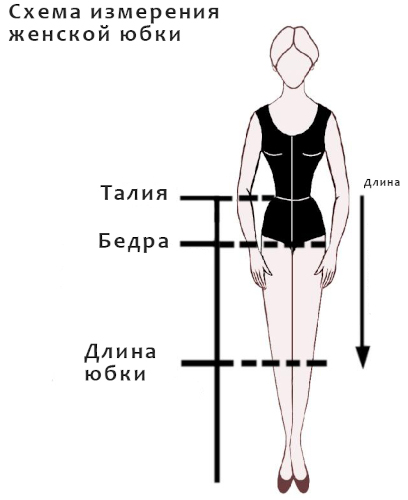
A skirt 98 cm long will look great on a girl of average height. Due to seam allowances and hemming, the final length of the fabric purchased should be no less than 105 cm. For the skirt to sit well on the hips, but not restrict movement, the width of the material should be at least 150 cm.
The principle of self-sewing such a skirt model is as follows:
- Lay the fabric face down on the table. Secure the edge of the fabric with sewing pins.
- Make a straight line across the entire width of the edge. Finish the hem.
- Turn the product inside out and carefully iron the seam from the front side.

- You will need a piece of thick lining fabric, the width of which should be the same as the piece of material originally used to sew the desired product. The length of the lining fabric should be selected in accordance with the width of the elastic band that needs to be made.
- The standard width of the elastic is 25 mm. The width of the lining should be 6.5 cm, since to form the drawstring (a folded/stitched strip of fabric, with the help of which a small groove is created for subsequent pulling of a cord or elastic) you need 3.5 cm of fabric, and 1.5 cm for seams.
- To make the drawstring look neat, its edges should be folded twice and a stitch should be made along the edge. The formed and processed drawstring is applied to the upper edge of the future skirt (front side). The joint of the drawstring and the seam of the skirt should match.
- Step back 15 mm from the edge to sew the drawstring. Overcast the inner edge before stitching. Bend the drawstring back a little and iron the product. Use a zigzag stitch to topstitch towards the drawstring, which is folded back to the wrong side of the skirt to iron the seam again.
- The free edge of the drawstring should be folded inward by 3.5 mm. To ensure that the material holds well, stitch a 3 mm line along the edge of the drawstring.
- The length of the elastic for the drawstring should be determined in accordance with the parameters of the figure, as it should not squeeze. Thread the elastic through the drawstring and fasten its ends.
- For the final finishing of the bottom edge of the product, fold it by 3 cm + 1.5 cm inward and stitch.
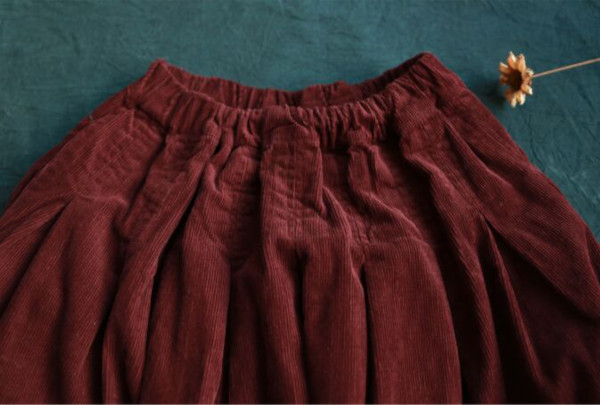
After the manipulations are done, you will get a stylish corduroy skirt that will suit all owners of wide hips and a thin waist. Thanks to the elastic band, the product will have gathers that will help smooth out all the reliefs of the figure. If a woman has extra pounds in the hip area, then the skirt should be lower-waisted.
Professional seamstresses recommend subjecting velvet to decatization (wet-heat treatment), as this procedure causes noticeable shrinkage.
In this case, the damp material is dried using a terry towel, and not wrung out in a washing machine. The prepared parts should be stitched with regular polyester threads and a universal needle No. 70 (80).
Pencil
A velveteen skirt should be present in every woman's wardrobe to create festive and everyday looks. Items made from this material are characterized by their durability, naturalness and strength. A universal style is a pencil skirt, which can emphasize the charms of any figure.

The main thing is to choose the right length of the product. For example, a skirt below the knees will help hide a few extra pounds in the hip area, emphasizing the waist and ankles, and for girls with narrow hips and an inexpressive waist, a skirt with a bottom edge 2-3 cm above the knees is ideal.
For decorating a skirt of this style, buttons with a loop on the back surface are ideal, as they look neater and more modern. It is best to process the loops in automatic or semi-automatic mode on a sewing machine.
To sew a skirt yourself, you need to take any pattern of a classic pencil skirt and make a few changes:
- Narrow the hem on both sides by 4-7 cm. The degree of narrowing of the product depends on its final length and the elasticity of the material used. At the same time, the hem should not be tight.
- There should be a small slit on the back of the product.
- From the top of the pattern, go down 25 cm to mark the taper parameters in both directions (4 cm each) along the hem line. This rule applies to both parts of the pattern.
- Taking into account the marks made, mark the new line of the future side seam.
- If you are going to sew a short skirt, then the narrowing along the side seams should be built on the part of the pattern that is intended for sewing a product 50-60 cm long. The pattern must be adjusted to the required length and the hem line should be slightly lowered at the level of the side stitches so that the fabric cannot fold during sewing.
- If you need to make an original cut consisting of 2 halves, one of which is superimposed on the other, then a rectangle 22 cm long should be drawn to the seam located in the center. The width of the rectangle should be within 6-8 cm.

It is necessary to fold the edges of the skirt slit, stitch them and iron them with a hot iron. All darts are stitched, and the side seams are stitched and processed on a sewing machine. It is also necessary to sew in a zipper. At the final stage, the top of the product is processed and the hem is stitched.
This item of women's clothing will look even better if you additionally sew fabric on the back side to strengthen the garment (give it the desired thickness and shape). To do this, the length of the garment should be reduced by 4 cm. The lining is sewn onto the finished product at the same time as the belt.
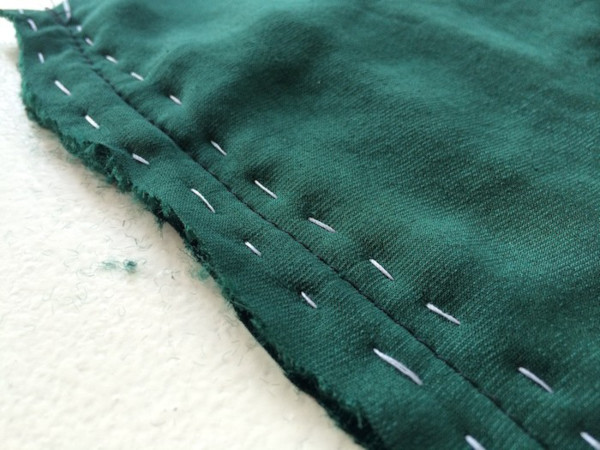
To visually make your figure more graceful, you should give preference to a model with a high waistline. Such a thing will help to hide the belly a little and emphasize the femininity of the figure.
Dark-colored fabric (e.g. dark blue, black, brown, burgundy) will help to enhance the effect. This style will look great on both slim and curvier girls.
With buttons in front
A corduroy skirt (styles for short women do not necessarily have to be above the knee, as you can opt for long, tight skirts, which are recommended to be combined with high-heeled shoes) with buttons in the front will suit a tall girl with a slender figure best. It is best to combine such an item with boots of a similar color and a turtleneck.
A basic pencil skirt pattern is perfect as a base.
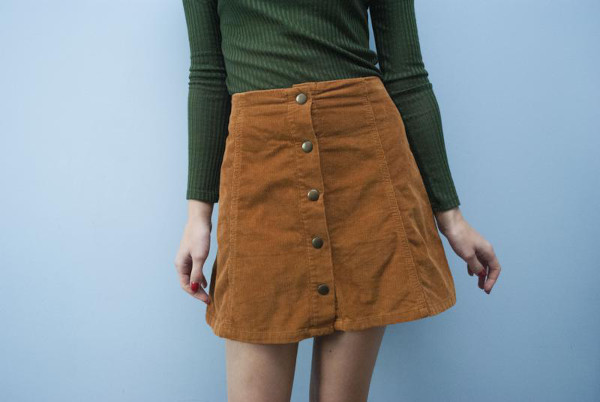
In this case, you need to perform several mandatory manipulations:
- On the front part of the pattern, draw a vertical line from the fold at the waist to the hem. Make a cut along the marked straight line.
- The cuts of the darts are connected to each other. Due to this, the front part of the product will become more flared.
- The resulting blank is outlined on the fabric. To complete the bar, you need to step back 1.5 cm from the center of the front part of the product on both sides. Add 3 cm of material from the bottom so that you can neatly hem the bar.
- The cut can be closed by adding 5 mm of fabric. The back of the skirt does not have strips, so there is no need to add additional cm of fabric.
- The 2 prepared halves of the product are cut out and folded together.
- To make a belt, you need to cut out a straight strip of fabric, the length of which will be proportional to the waist circumference (WC). The width of the product should match the width of the bar. 5 cm of velveteen are added for seam allowances. A strip is cut out of thermal fabric (a material with special glue applied to one side) in accordance with the width of the belt.
- It remains to finish processing the strip. For this, you will need a piece of fabric of identical size, which is applied with the wrong side to the main part of the skirt. All cuts are ironed.

Both parts of the future skirt are folded together with the front side down, and the seams are stitched along the sides. To avoid damaging the velveteen pile, all the seams need to be processed on a sewing machine. A zigzag stitch will look best. The belt is processed in the same way as the placket.
The product is turned inside out and the edges are ironed. It is necessary to fold the strip along the pre-ironed fold and stitch it carefully. In the upper part of the product, a belt is fixed with sewing pins, the edge of which should go 10 mm beyond the formed strip.
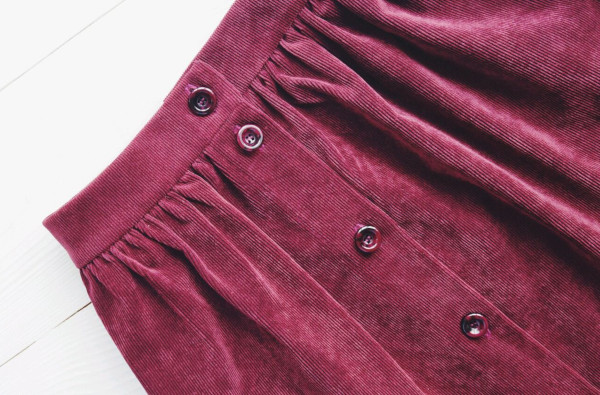
All that remains is to sew on the belt, sew the folded edges inward, form small loops and sew on buttons that match in color and shape. The final step is to sew on the hem.
Trapezoid
A corduroy skirt (styles for women with curvy hips should not have flounces or wedges at the bottom, otherwise it will not be possible to create a harmonious image, because visually the hips will appear even larger, and they will attract attention to themselves) of a trapezoid shape is perfect for work and business trips.

This model will help to hide excess weight in the abdomen and hips. The trapezoid skirt is ideal for those with a pear-shaped figure. The product should be combined with light, airy blouses. For work, you will need a basic pattern of a straight-cut skirt.
To achieve the desired result, you need to do the following:
- From the bottom of the skirt, you should set aside 5-15 cm. It is necessary to draw a new line for the side seam, making the bottom of the product slightly rounded. The side cuts are raised, thereby leveling the length of the skirt. Small darts are left at the waist.
- The prepared pattern is carefully cut out and transferred onto the velveteen.
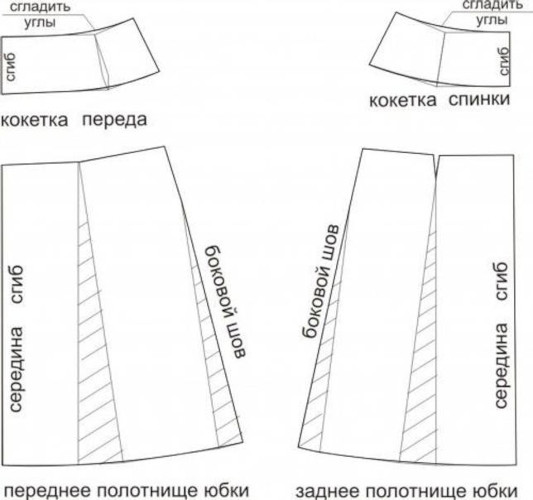
The front and back parts of the future skirt are pressed together so that the front side of the material is inside. Then they begin working on the side seams.
The edges are processed on a sewing machine, the lower edge of the product is hemmed. The belt is made according to the same principle as in the case of a classic straight skirt. The edges of the belt are ironed. All that remains is to sew in the zipper and you can try on the skirt.
The zipper is sewn correctly if it is securely hidden from prying eyes when fastened. The zipper should be deepened into the fabric. Outside the waistband (from the front side), the teeth of the zipper should be almost invisible.
With smell
A skirt of this model suits all representatives of the fair sex, regardless of figure parameters and age. A not too tight wrap skirt is a universal item in the wardrobe of girls with curvy shapes, as such a product allows you to experiment with images.
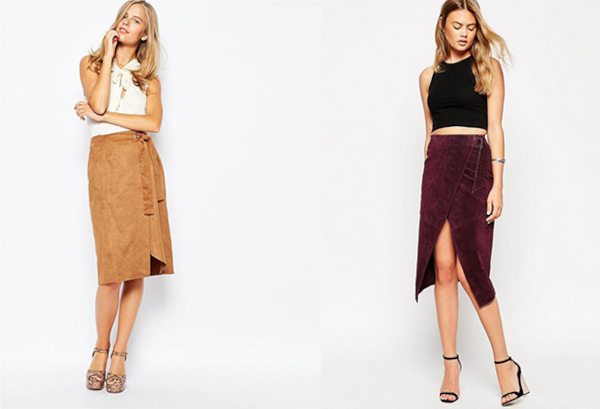
To sew a skirt yourself, you will need a basic pattern, the construction of which will take 5-10 minutes. All manipulations are carried out with 1 piece of fabric. The bottom edge of the skirt should be rounded.
Scheme of actions:
- Draw a rectangle, the length of which will correspond to the waist. Additionally, you will need another 18 cm of fabric (to form the wrap and make neat seams). The length of the desired skirt + 4 cm for seams = the width of the required pattern.
- Cut out the finished piece from the prepared piece of fabric. Turn the material under at the waist.
- On the back, mark within two darts, which are sewn and ironed.
- The skirt is laid out on the table and its lower part is rounded.
- The edges are ironed with a hot iron and adhesive tape is applied.
- The edge of the product is carefully folded, the ribbon is hidden and ironed.
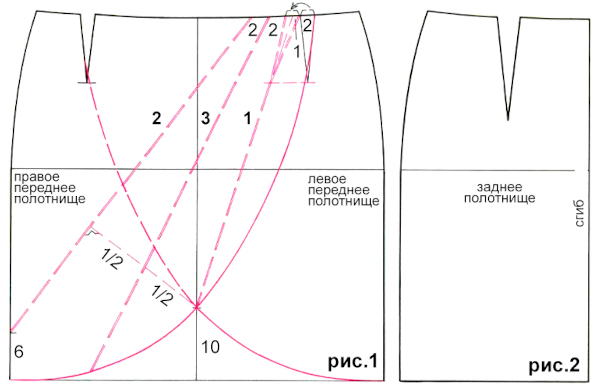
Instead of classic buttons, you can use original fasteners, Velcro or even ribbons.
Flared
There is a common option for sewing a flared skirt for beginners. In this case, the pattern includes 2 circles of a larger and smaller diameter. At the first stage of work, you need to calculate the radius (R) of the circles. The pattern should be constructed on paper, which should be folded in half.
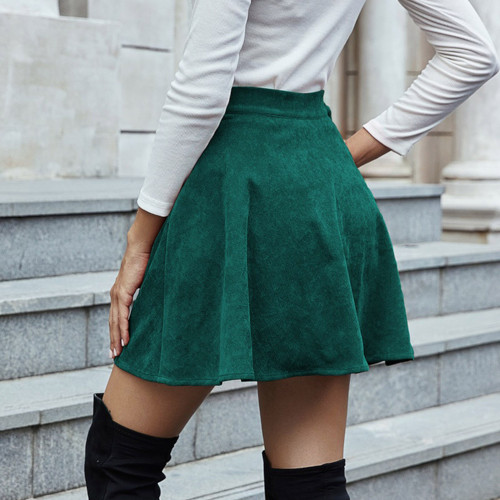
Scheme of actions:
- Measure your waist and add another 4 cm to the results for seams.
- The circumference corresponds to the product of the number tt and the diameter of the circle. To find out the R of the circle, you need OT/2 of the number tt. For example, the circumference = 65, then first of all you need to divide this value by tt: 65/tt (3.14) = 20.70 cm. We divide the obtained value by 2 to calculate the required parameter: 20.70/2 = 10.35 cm.
- On paper, mark off the segments that will correspond to the previously calculated R. The segments can be designated with letters: A, A1, B, B1.
- Construct a right angle (90) so that its vertex is point A.
- Put aside 1 segment on each side of the right angle, which in sum are identical to R of the small circle. Draw a closed flat curve (circle) with a compass. If you have already decided on the length of the future skirt, then you need to put aside segments A1B1 and A2B2 on the sides of the right angle.
- From point A, set aside R. In this case, R of the resulting circle must correspond to the sum of two segments: AA1 and A1B1. You need to draw a larger circle.
- Cut out the resulting piece and turn it over. The pattern is transferred to the fabric step by step, taking into account all allowances.
- For the belt, you should cut a ribbon that should correspond to the OT + 4 cm for seams. The width of the ribbon is increased by 2 times + 4 cm for seams.
To sew a flared skirt yourself, you need to connect the waistband and lining. The edges are gradually folded on both sides, turning the material inside out.
The belt is folded lengthwise so that the front side is inside. The part is fixed with sewing pins. The edges of the belt are stitched on both sides and turned inside out. The bottom of the product is folded under, the seam is ironed. All that remains is to stitch the belt and sew in the zipper.
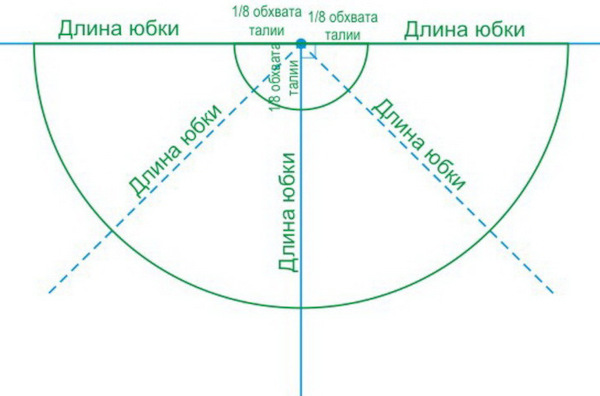
| Calculating R for different conical skirt models | |||
| Type of skirt | Coefficient | Raising the pelvic line | Raising the line bottom |
| Flared | 1.4 | 0.5 | 1.0 |
| Big flare | 1,2 | 0.75 | 1.5 |
| Half Sun | 0.64 | 1.75 | 3.5 |
| Sun | 0.32 | 2.0 | 4.0 |
| Small bell | 1.0 | 1.0 | 2.0 |
| Middle bell | 0.9 | 1.25 | 2.5 |
| Big bell | 0.8 | 1.5 | 3.0 |
Conical skirts are those models in which the difference between the measurement of the half-waist and the width of the product at the bottom of the folded part is twice as much as 2/3 of the entire length. In this case, skirt models can be single-seam or multi-seam.
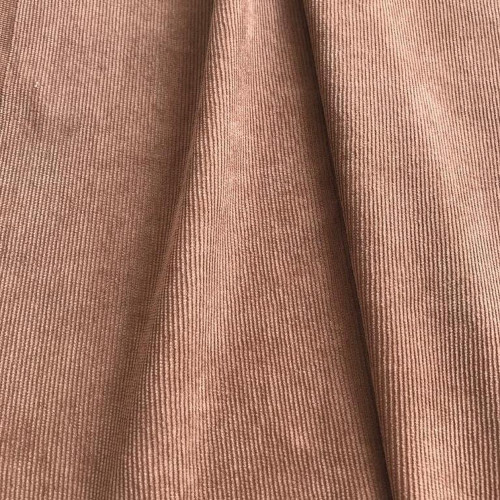
To evenly distribute the soft folds on the skirt and create a smooth hem, experienced seamstresses make changes to the pattern. For example, along those lines that are laid at an acute angle (45) to the base lines, the hem and waist lines are raised. The final parameters for raising the lines depend on the specific model.
Boho
A velveteen skirt (styles for women with curvy hips should not be made from material with a large rib, since otherwise the hips will visually appear even larger, and the legs will look massive and short) in the boho style allows for the presence of decorative elements such as fringe, lace, and various prints.

A wrap boho skirt looks original and stylish. This style allows you to adjust the waistline yourself. Due to this, girls with clothing sizes from 42 to 48 can use only one skirt model.
To correctly construct the pattern, you need to know what the length of the product should be from the waistline. The ties will allow you to adjust the width of the skirt. First, draw a circle on paper with the radius of the skirt length.
Exactly 50% of the circle is reduced so that 1/2 is in the continuation of the radius along a quarter of the circle. There should be a smooth transition from a larger diameter to a smaller one with middle lines (1/4, 3/4).
Next, a boho-style velvet skirt is made according to the following pattern:
- Make a belt 170 cm long and 10 cm wide. Sew the sides of the belt and make 2 lines (along the lower and upper parts). At the waistline, sew the belt to the skirt along the upper part.
- The edges of the skirt are processed using an overlock machine.
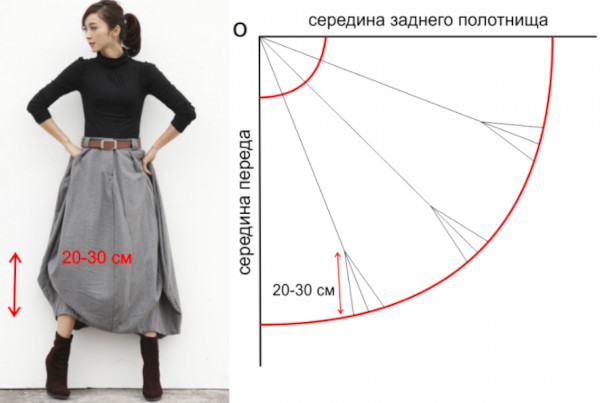
Boho skirts are best combined with tunics and loose-fitting blouses. No less impressive will be knitted vests, tops and T-shirts that can be worn loose with a belt/belt or tucked in.
In autumn and spring, you can throw on a leather or denim vest, a loose cardigan or a knitted cape. A voluminous backpack-shaped bag decorated with embroidery, various straps, appliques and/or fringe will help complete the look.
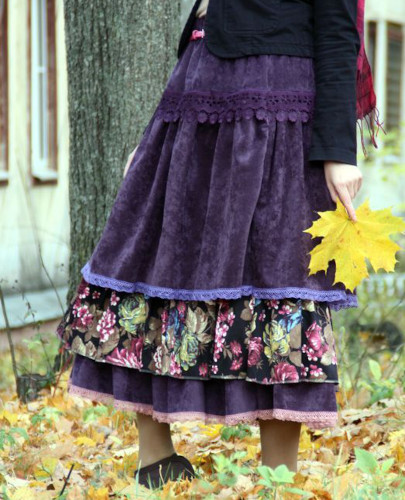
A wide variety of corduroy skirt styles allows every woman (regardless of age, weight and body type) to choose the best option for business meetings, romantic dates and walks in the fresh air. At the same time, corduroy keeps warm well, has an affordable price and an attractive appearance.
If you properly care for a skirt made from this fabric, it will retain its original shape and pile color for a long time. To do this, you should use only dry methods of cleaning clothes (using a special lint brush, a roller with a sticky coating), hand washing and steaming.

Even for an experienced seamstress, it is more difficult to sew things from corduroy than from cotton fabric, but the end result is worth it. With a pattern and the necessary materials, you can sew a stylish corduroy skirt of any style at home. Detailed instructions and recommendations from experts will help you avoid common mistakes so that the result exceeds all expectations.
Video about velvet skirt
Corduroy skirt with buttons and pockets:
